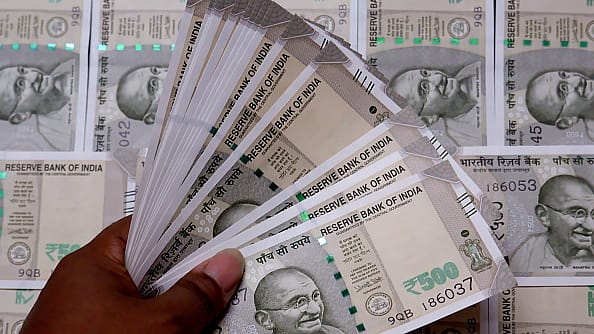Gloomy quadrilateral sank rupee 11% in 2022
ADVERTISEMENT

Spiking Crude, rising imports, ballooning trade deficit and pessimistic foreign investors made the Indian rupee depreciate over 11% in 2022. The gloomy quadrilateral is a depressing concoction of these factors that brought the rupee to its poorest performance since 2013 when it lost 15% against the USD.
Against the backdrop of the strengthening of the Dollar Index that made its two-decade high in September 2022, the rupee managed to close the year at 82.61 to the US dollar, down from 74.29 at end of 2021.
Despite poor performance for the year, on the last trading day, the rupee gained 26 paise and closed at 82.61 against the US dollar.
Only the Turkish Lira and British Pound among major currencies faced worse drubbing than the Indian rupee in 2022.
Rising trade deficit makes rupee weak
India is a commodity-dependent nation and heavily imports crude and gold. Yellow metal and crude account for around one-third of India’s current account deficit and higher prices for both commodities is bad news for the nation’s financial health. India’s crude oil import bill surged 76% to $90.3 billion in the first half of 2022-23.
December 2025
The annual Fortune 500 India list, the definitive compendium of corporate performance, is out. This year, the cumulative revenue of the Fortune 500 India companies has breached $2 trillion for the first time. Plus, find out which are the Best B-schools in India.
In 2020-21, India’s total import bill was $394 billion, of which 21%, or $83 billion, was contributed by crude alone. India’s merchandise import in 2021-22 was $610.22 billion, of which a whopping 26.3% or $160.68 billion, was contributed by crude alone. In 2018-19, when crude prices spiked to $88 per barrel, India’s oil imports touched $141 billion, which was 27.43% of total imports worth $514 billion.
Apart from crude, higher gold prices are also a potent threat to the Indian rupee. Like oil, India, too, imports yellow metal heavily. Import of yellow metal rose over one-third from $34.6 billion in FY21 to $46.1 billion in FY 22. Between April-November 2022, India imported 473.2 metric tonnes of gold while in the last fiscal (FY 22) India imported 800.2 metric tonnes.
Between FY21 and FY22, the nation’s total import bill rose by 54.7% from $394.44 billion to $610.22 billion.
Experts believe higher commodity prices, especially crude and gold, could sink the rupee further in 2023.
Shinhan Bank, a premiere South Korean Investment Bank, views that in 2023, USD/INR is expected to weaken in the first half due to economic slowdown but is likely to rebound in the second half. The expected annual range for USD-INR is 77-84.5, says the bank in its recently published report.
As per an RBI research paper dated January 04, 2019, a $10 per barrel increase in oil price could raise inflation by roughly 49 basis points and increase the fiscal deficit by 43 basis points (as a percentage of GDP).
Authors of the research report, Saurabh Ghosh and Shekhar Tomar, made these observations based on the presumption that such an impact would happen if the government decides to absorb the entire oil price shock rather than passing it to the end consumers. The report also says that for every $10 increase in oil price, the oil trade deficit (oil import minus oil export) would go up by $12.5 billion.
Since 2014, gold accounted for around 7-8% of India’s overall imports, as per the World Gold Council.
In 2021, India’s gold import was just short of 1,000 metric tonnes, and the country ended the year by importing 984 metric tonnes of gold. In the first nine months of 2022, India imported 515 metric tonnes of the yellow metal. Last time when India’s imports crossed over 1,000 metric tonnes (in 2011), the Nifty index slipped 25% that year. Any spike in gold import in four digits in 2022 will spell trouble for trade deficit numbers and negatively impact the rupee and Indian equity markets.
Rising import bills on account of high crude and gold prices in the international market too weighed negatively on the flows by Foreign Institutional Investors. Foreign investors pulled out a net sum of $16.5 billion (₹1.21 lakh crore) from the Indian equity markets and over ₹16,000 crore from the debt markets in 2022 owing to an aggressive rate hike by central banks globally.
Outlook for rupee in 2023
Though the RBI spent more than a hundred billion dollars to prop up the sliding rupee, it crossed the psychological mark of 83 to greenback.
Yet, there are some silver linings. There are indications that the US Fed will further reduce the intensity of rate hikes in the coming year. Also, global investors have not lost confidence in Indian markets, and FII inflows have begun to improve. In November, FPIs invested ₹36,239 crore into Indian equities, while in December, FPIs pumped in ₹11,119 crore.
Also, declining global energy prices, strong fundamentals of the Indian economy and inflation coming back to the Reserve Bank's comfort level will help the rupee regain some strength against the USD.
